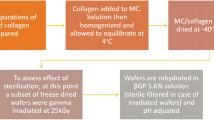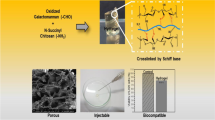Abstract
Although local cell delivery is an option to repair tissues, particularly using chitosan-based hydrogels, significant attrition of injected cells prior to engraftment has been a problem. To address this problem, we explored the possibility of stabilizing the chitosan–gelatin (CG) injectable hydrogels using (1) controlled release of doxycycline (DOX) to prevent premature degradation due to increased gelatinase activity (MMP-2 and MMP-9), and (2) transglutaminase (TG) to in situ cross-link gelatin to improve the mechanical stability. We prepared DOX-loaded PLGA nanoparticles, loaded into the CG hydrogels, measured DOX release for 5 days, and modeled using a single-compartmental assumption. Next, we assessed the influence of TG and DOX on hydrogel compression properties by incubating hydrogels for 7 days in PBS. We evaluated the effect of these changes on retention of fibroblasts and alterations in MMP-2/MMP-9 activity by seeding 500,000 fibroblasts for 5 days. These results showed that 90 % of DOX released from cross-linked CG hydrogels after 4 days, unlike CG hydrogels where 90 % of DOX was released within the first day. Addition of TG enhanced the CG hydrogel stability significantly. More than 60 % of seeded fibroblasts were recovered from the CG-TG hydrogels at day 5, unlike 40 % recovered from CG-hydrogels. Inhibition of MMP-2/MMP-9 were observed. In summary, controlled release of DOX from CG hydrogels cross-linked with TG shows a significant potential as a carrier for cell delivery.





Similar content being viewed by others
References
Segers VF, Lee RT. Stem-cell therapy for cardiac disease. Nature. 2008;451:937–42.
Ye Z, Zhou Y, Cai H, Tan W. Myocardial regeneration: roles of stem cells and hydrogels. Adv Drug Deliv Rev. 2011;63:688–97.
Kurdi M, Chidiac R, Hoemann C, Zouein F, Zgheib C, Booz GW. Hydrogels as a platform for stem cell delivery to the heart. Congest Heart Fail. 2010;16:132–5.
Pascual-Gil S, Garbayo E, Díaz-Herráez P, Prosper F, Blanco-Prieto MJ. Heart regeneration after myocardial infarction using synthetic biomaterials. J Control Release. 2015;203:23–38.
Slaughter BV, Khurshid SS, Fisher OZ, Khademhosseini A, Peppas NA. Hydrogels in regenerative medicine. Adv Mater. 2009;21:3307–29.
Behfar A, Crespo-Diaz R, Terzic A, Gersh BJ. Cell therapy for cardiac repair-lessons from clinical trials. Nat Rev Cardiol. 2014;11:232–46.
Menasche P. Cardiac cell therapy: lessons from clinical trials. J Mol Cell Cardiol. 2011;50:258–65.
Guskiewicz KM, Mihalik JP. Biomechanics of sport concussion: quest for the elusive injury threshold. Exerc Sport Sci Rev. 2011;39:4–11.
Chenite A, Chaput C, Wang D, Combes C, Buschmann MD, Hoemann CD, et al. Novel injectable neutral solutions of chitosan form biodegradable gels in situ. Biomaterials. 2000;21:2155–61.
Cheng YH, Yang SH, Su WY, Chen YC, Yang KC, Cheng WT, et al. Thermosensitive chitosan-gelatin-glycerol phosphate hydrogels as a cell carrier for nucleus pulposus regeneration: an in vitro study. Tissue Eng A. 2010;16:695–703.
Ngoenkam J, Faikrua A, Yasothornsrikul S, Viyoch J. Potential of an injectable chitosan/starch/beta-glycerol phosphate hydrogel for sustaining normal chondrocyte function. Int J Pharm. 2010;391:115–24.
Huang Y, Siewe M, Madihally SV. Effect of spatial architecture on cellular colonization. Biotechnol Bioeng. 2006;93:64–75.
Mi FL, Tan YC, Liang HF, Sung HW. In vivo biocompatibility and degradability of a novel injectable-chitosan-based implant. Biomaterials. 2002;23:181–91.
Hong Y, Song H, Gong Y, Mao Z, Gao C, Shen J. Covalently crosslinked chitosan hydrogel: properties of in vitro degradation and chondrocyte encapsulation. Acta Biomater. 2007;3:23–31.
Lu WN, Lu SH, Wang HB, Li DX, Duan CM, Liu ZQ, et al. Functional improvement of infarcted heart by co-injection of embryonic stem cells with temperature-responsive chitosan hydrogel. Tissue Eng A. 2009;15:1437–47.
Huang Y, Onyeri S, Siewe M, Moshfeghian A, Madihally SV. In vitro characterization of chitosan-gelatin scaffolds for tissue engineering. Biomaterials. 2005;26:7616–27.
Yung CW, Wu LQ, Tullman JA, Payne GF, Bentley WE, Barbari TA. Transglutaminase crosslinked gelatin as a tissue engineering scaffold. J Biomed Mater Res Part A. 2007;83:1039–46.
Iyer P, Walker KJ, Madihally SV. Increased matrix synthesis by fibroblasts with decreased proliferation on synthetic chitosan-gelatin porous structures. Biotechnol Bioeng. 2012;109:1314–25.
Makowski GS, Ramsby ML. Identification and partial characterization of three calcium- and zinc-independent gelatinases constitutively present in human circulation. Biochem Mol Biol Int. 1998;46:1043–53.
Broderick EP, O’Halloran DM, Rochev YA, Griffin M, Collighan RJ, Pandit AS. Enzymatic stabilization of gelatin-based scaffolds. J Biomed Mater Res Part B. 2005;72:37–42.
McDermott MK, Chen T, Williams CM, Markley KM, Payne GF. Mechanical properties of biomimetic tissue adhesive based on the microbial transglutaminase-catalyzed crosslinking of gelatin. Biomacromolecules. 2004;5:1270–9.
Greenberg CS, Birckbichler PJ, Rice RH. Transglutaminases: multifunctional cross-linking enzymes that stabilize tissues. FASEB J Off Publ Fed Am Soc Exp Biol. 1991;5:3071–7.
Lim L-T, Mine Y, Tung MA. Barrier and tensile properties of transglutaminase cross-linked gelatin films as affected by relative humidity, temperature, and glycerol content. J Food Sci. 1999;64:616–22.
Joseph D, Lanier TC, Hamann DD. Temperature and pH affect transglutaminase-catalyzed “setting” of crude fish actomyosin. J Food Sci. 1994;59:1018–23. 1036.
Jones MER, Messersmith PB. Facile coupling of synthetic peptides and peptide-polymer conjugates to cartilage via transglutaminase enzyme. Biomaterials. 2007;28:5215–24.
Aeschlimann D, Paulsson M. Transglutaminases: protein cross-linking enzymes in tissues and body fluids. Thromb Haemost. 1994;71(4):402–15.
Liu Y, Kopelman D, Wu LQ, Hijji K, Attar I, Preiss-Bloom O, et al. Biomimetic sealant based on gelatin and microbial transglutaminase: an initial in vivo investigation. J Biomed Mater Res B Appl Biomater. 2009;91B:5–16.
Tomasek JJ, Halliday NL, Updike DL, Ahern-Moore JS, Vu TK, Liu RW, et al. Gelatinase A activation is regulated by the organization of the polymerized actin cytoskeleton. J Biol Chem. 1997;272:7482–7.
Newby AC. Matrix metalloproteinase inhibition therapy for vascular diseases. Vasc Pharmacol. 2012;56:232–44.
Agwuh KN, MacGowan A. Pharmacokinetics and pharmacodynamics of the tetracyclines including glycylcyclines. J Antimicrob Chemother. 2006;58:256–65.
Davda J, Labhasetwar V. Characterization of nanoparticle uptake by endothelial cells. Int J Pharm. 2002;233:51–9.
Murakami H, Kobayashi M, Takeuchi H, Kawashima Y. Preparation of poly(DL-lactide-co-glycolide) nanoparticles by modified spontaneous emulsification solvent diffusion method. Int J Pharm. 1999;187:143–52.
Hong JK, Madihally SV. Three-dimensional scaffold of electrosprayed fibers with large pore size for tissue regeneration. Acta Biomater. 2010;6:4734–42.
Walker KJ, Madihally SV. Anisotropic temperature sensitive chitosan-based injectable hydrogels mimicking cartilage matrix. J Biomed Mater Res B Appl Biomater. 2014;103(6):1149–60.
Ratakonda S, Sridhar UM, Rhinehart RR, Madihally SV. Assessing viscoelastic properties of chitosan scaffolds and validation with cyclical tests. Acta Biomater. 2012;8:1566–75.
Ramesh VM, Bingham SE, Webber AN. A simple method for chloroplast transformation in Chlamydomonas reinhardtii. Methods Mol Biol. 2011;684:313–20.
Costa P, Sousa Lobo JM. Modeling and comparison of dissolution profiles. Eur J Pharm Sci Off J Eur Fed Pharm Sci. 2001;13:123–33.
Waas ET, Lomme RM, DeGroot J, Wobbes T, Hendriks T. Tissue levels of active matrix metalloproteinase-2 and -9 in colorectal cancer. Br J Cancer. 2002;86:1876–83.
Bode F, da Silva MA, Drake AF, Ross-Murphy SB, Dreiss CA. Enzymatically cross-linked tilapia gelatin hydrogels: physical, chemical, and hybrid networks. Biomacromolecules. 2011;12:3741–52.
Giovagnoli S, Tsai T, DeLuca PP. Formulation and release behavior of doxycycline-alginate hydrogel microparticles embedded into pluronic F127 thermogels as a potential new vehicle for doxycycline intradermal sustained delivery. AAPS PharmSciTech. 2010;11:212–20.
Franco C, Ho B, Mulholland D, Hou G, Islam M, Donaldson K, et al. Doxycycline alters vascular smooth muscle cell adhesion, migration, and reorganization of fibrillar collagen matrices. Am J Pathol. 2006;168:1697–709.
Ravanti L, Heino J, Lopez-Otin C, Kahari V-M. Induction of collagenase-3 (MMP-13) expression in human skin fibroblasts by three-dimensional collagen is mediated by p38 mitogen-activated protein kinase. J Biol Chem. 1999;274:2446–55.
O Halloran DM, Collighan RJ, Griffin M, Pandit AS. Characterization of a microbial transglutaminase cross-linked type II collagen scaffold. Tissue engineering. 2006;12:1467–74.
Acknowledgments
Financial support was provided by the Oklahoma Center for Advancement of Science and Technology (HR12-023) and by the Edward Joullian Endowment. CJT is a McNair Scholar and CA was supported by Wentz Scholarship and Niblack Scholarship.
Conflict of interest
There are no conflict of interests to disclose.
Author information
Authors and Affiliations
Corresponding author
Rights and permissions
About this article
Cite this article
Tormos, C.J., Abraham, C. & Madihally, S.V. Improving the stability of chitosan–gelatin-based hydrogels for cell delivery using transglutaminase and controlled release of doxycycline. Drug Deliv. and Transl. Res. 5, 575–584 (2015). https://doi.org/10.1007/s13346-015-0258-7
Published:
Issue Date:
DOI: https://doi.org/10.1007/s13346-015-0258-7




